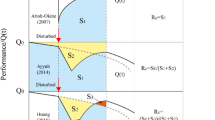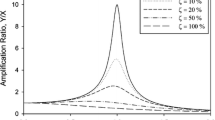Abstract
To research the failure characteristics on the extraordinarily fire explosion accident which happened in Tianjin Port, through detailed site investigation and related numerical calculation, a new formula of the shock wave overpressure which can be used in near field and far field are proposed, and the formula was contrasted and validated with the actual damage. Finally, according to the explosive power and the distance from explosive source, the damaging range is divided into different damage levels. In this paper, some salient characteristics of the fire explosion accident are discovered and discussed. The results indicates that this model can depict the damage situation well in near field and far field and it can supplement and revise the planning on earthquake resistance and hazardous prevention.
Similar content being viewed by others
References
AEL-Kadi., Iremonger, M. J., and Kennedy, L. J. (1997). “The influence of architectural design and features on the response of glassing to explosive blast.” in Proceeding of the 8 th International symposium on Interaction of the Munitions with Structures, Mclean, Virginia, 21-25April.
Beijing University of Technology (1979). Explosion and Its Effect, National Defend Industry Press, Beijing, China.
Beshara, F. B. A. (1994). “Modeling of blast loading on aboveground structures-I. General phenomenology and external blast.” Computers and Structures, Vol. 51, No. 5, pp. 585–596, DOI: 10.1016/0045-7949(94)90066-3.
Beshara, F. B. A. (1994). “Modeling of blast loading on aboveground structures-II. Internal blast and ground shock,” Computers and Structures, Vol. 51, No. 5, pp. 597–606, DOI: 10.1016/0045-7949 (94)90067-1.
Brode, H. L. (1959). “Blast wave from a spherical charge.” Phys Fluids, Vol. 2, pp. 217.
Cai, F., Chen, X. R., and Chen, Q. S. (2006). “Research on interference of wind load on complicated-structured buildings.” Building Science, Vol. 22, No. 5, pp. 39–42, DOI: 10.13614/j.cnki.11-1962/tu.2006.05.009.
Dong, S. H. (1996). “Review on failure criteria of the explosion shock wave.” Petrochemical Safety Technology, Vol. 12, No. 4, pp. 40–41.
Fahmy, A. and Tolba, F. (2001). Response of FRP-retrofitted Reinforced Concrete Panels to Blast Loading, Carleton University, Ottawa, Canada.
GB6722-2014. (2014). Chinese Safety Regulations for Blasting, China.
Henrych, J. (1979). The dynamics of explosion and its use, Elsevier Scientific Pub co, New York, USA.
Remennikov, A. M. (2005). Modelling blast loads on buildings in complex city geometries.” Computers and Structures, Vol. 83, No. 27, pp. 2197–2205, DOI: 10.1016/j.compstruc.2005.04.003.
Rose, T. A. and Smith, P. D. (2002). “Influence of the principal geometrical parameters of straight city streets on positive and negative phase blast wave impulses.” International Journal of Impact Engineering, vol. 27, no.4, pp.359–376, DOI: 10.1016/S0734-743X(01)00060-4.
Sadovskyi, M. A. (1952). Mechanical action of air shock waves of explosion, based on experimental data, Izd Akad Nauk SSSR, Moscow.
Simiu, E. and Scanlan, R. H. (1996). Wind Effects on Structures: Fundamentals and Applications to Design, Wiley-Interscience, New York, USA.
Smith, P. D. and Rose, T. A. (2006). “Blast wave propagation in city streets-an overview.” Progress in Structural Engineering and Materials, Vol. 8, No.1, pp. 16–28, DOI: 10.1002/pse.209.
Wu, C. and Hao, H. (2005). “Modeling of simultaneous ground shock and A inb last pressure on nearby structures from surface explosions.” Int J Impact Eng, Vol. 31, No. 6, pp. 669–717.
Yan, G. J., Zhou, M. A., and Yu, L. (1994). “Prediction of overpressure of explosive blast in the air,” Computers and Structures, Vol. 11, No. 5, pp. 597–606, DOI: 10.13828/j.cnki.ckjs.2011.05.012.
Yang, X., Shi, S. Q., and Cheng, P. F. (2005). “Forecast and simulation of peak overpressure of TNT explosion shock wave in the air.” Blasting, Vol. 25, No. 1, pp. 15–19.
Author information
Authors and Affiliations
Corresponding author
Rights and permissions
About this article
Cite this article
Li, J., Ma, D. The studies for building failure characteristics of the extraordinarily fire explosion accident in Tianjin Port. KSCE J Civ Eng 22, 718–724 (2018). https://doi.org/10.1007/s12205-017-1339-6
Received:
Revised:
Accepted:
Published:
Issue Date:
DOI: https://doi.org/10.1007/s12205-017-1339-6




